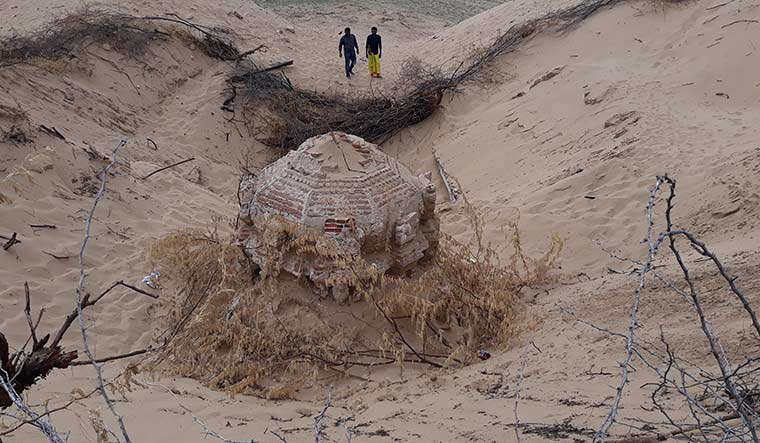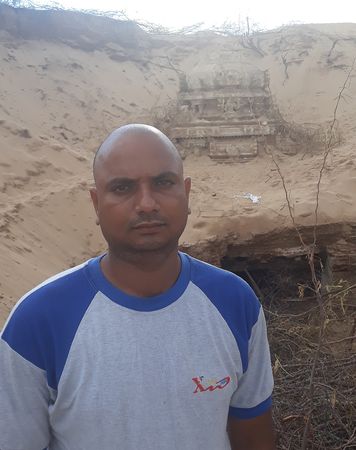IN THE 1850s or so, a series of unusual events rocked Perumallapadu village on the River Penna, which empties into the Bay of Bengal. One day, the village, which was then part of the Madras Presidency, woke up to the news of a village elder’s death. Mourners carried Vemana Narsapa Naidu’s body to the cremation grounds outside the village. Legend has it that, just before lighting the pyre, a relative whispered a few words in his ears as per Hindu custom. Suddenly, Naidu sprung back to life. He then told the mourners that he had received divine instructions to restore a Shiva temple built by Parasurama. In the years that followed, Naidu reconstructed the temple, which came to be known as the Sri Nageswara temple.
“He restored the temple, dug a koneru (pond) and reared a tamarind grove with his property. The temple is in the shape of a tower. Nandeeswara is installed in front of this temple,” reads an excerpt from a 1961 manual, which is in the possession of the state archaeology and museums department.
Lore has it that around 60 years ago the Penna river changed course after a flood. The temple itself was buried by the sand and debris carried by the floodwaters. The floods forced the villagers to shift 1km away. Over time, the 800-odd villagers forgot the location of the temple.
Cut to 2020. Till early this year, Potugunta Vara Prasad was busy developing software at an IT firm in Stockholm. And then the pandemic struck. Prasad, 36, was given the option of staying put in Sweden or returning to India and working from home. He chose the latter, wanting to be with his parents, wife and son in Perumallapadu, in Nellore district of Andhra Pradesh.
Growing up, Prasad, like most of the villagers here, had heard the legend about the temple. “Deep in my heart, I always wished to see the temple. I wanted to find it in my lifetime,” said Prasad. While Naidu’s decision to restore the temple was a divine calling, Prasad decided to look for the temple after his spiritual guru from the adjoining village told him to do so around five years ago. Every time he visited the guru, he would remind Prasad about the temple. Prasad, perhaps, never had the time earlier, but the pandemic provided him with the perfect opportunity.
On his return from Stockholm in March, Prasad quarantined himself for a month. Like him, around 50 young men had returned home owing to the pandemic. “After the quarantine period, I felt lively, meeting my friends, family and walking around the village,” he said. “We spent the initial days playing cricket and gossiping.”
Soon, Prasad broached the topic of the temple with the young men. When he got their support, he approached the village elders. “They had a lot of doubts. I came back with a plan and presented it to them,” he said. “Then we sat together and brainstormed. Finally, there was a consensus on going ahead with the excavation.”
According to the villagers, previous attempts to find the temple had failed, and they had little hope of success this time, too. Nonetheless, Prasad, like Naidu, decided to fund the exercise. “We approached the local endowments department and sought permission,” said Mannem Manohar, 21, an engineering graduate who had returned to the village from Nellore city. He was part of the group that held discussions with officials. “We explained the importance of the temple,” said Manohar. “A few days later, they gave us oral permission.”
On June 15, the villagers gathered at the spot where they thought the temple once stood. Eyewitnesses said that the atmosphere was festival-like. Prasad’s spiritual guru was also present. An earth-mover was rented and, after an elaborate prayer session, the excavation began. Hours passed, but there was no sign of the temple. By evening the villagers were demoralised. The turning point came just as they were getting ready to throw in the towel.
“A shepherd who lives on the outskirts of our village came to us,” said Manohar. “He said that we should dig at a particular spot. We did not take him seriously. But he was insistent.”
The next morning, the villagers gathered at a new location. At around 7am, the excavation started. In an hour, a pointed structure was unearthed. It was the tip of the entrance tower of the long-lost temple. “I had tears in my eyes. It was an unbelievable feeling,” said Prasad.
As the villagers celebrated, the young among them posted photos and videos on social media. Soon, the posts went viral and hundreds of people from different parts of the district streamed to the site. While some wanted to click pictures, others came to pray. Government officials, too, reached the site.
“The area has been designated as a containment zone and such crowds cannot be allowed during a pandemic,” said mandal revenue officer Geetha Vani, who was among the first officers to reach the spot. “We held discussions with the villagers and immediately stopped the activity. We barricaded the site and secured the place so that it does not turn into a picnic spot. It is dangerous for people to go inside the structure as it can collapse anytime. We have to ascertain the facts related to this temple. We have written to the collector and endowments department.”
Currently, only a quarter of the temple has been excavated. The outer walls and the top portion of the temple have sculptures of goddesses. A narrow passage hemmed in by sand mounds leads to the main entrance. There is visible damage to the structure; the woodwork and bricks are exposed. According to locals and officials, all idols and ornaments from the temple were shifted to another temple just before the floods had hit the region.
Meanwhile, officials of the state archaeology and museums department, who were unaware of the existence of the temple, are trying to find out the age, history and the significance of the structure. “Preliminary examination has revealed that stones were not used in the construction,” said assistant director O. Ramasubba Reddy. “Only lime mortar, wood and bricks were used. This structure does not seem to have the influence of the Pallava-Chola style of architecture, which is found in other temples in this region. It is difficult to tell the age of the temple till we have a closer look at the inscriptions.” On his visit to the temple on the first day, Reddy spotted something strange. “The tiles in one section inside the temple were dug up,” said Reddy. “It is strange and we have to find out why.”
The village youth now take turns to visit the site every day to make sure there are no trespassers. Prasad and his team are now waiting to discuss with officials the next step in the restoration process. Prasad came to know about Naidu’s temple restoration initiative only after the team found the structure. And, to his utter surprise, one of Naidu’s descendants—Vemana Dasaradha Rama Naidu—is his neighbour. In his 70s, Dasaradha had walked all the way to the temple when the excavation began. “It was a different feeling seeing the temple as my ancestors built it,” he said. “I faintly remember playing inside the temple as a child. My grandparents told us stories about the temple and the village, when it was situated on the riverbank. All I want to do is go inside the temple and spend time there.”



